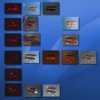mauricemeyer
New Hunter
I'm considering making up a chest display and wanted to run it by the group before going off in the wrong direction. The main thing is that I need a smaller one for my kid's costume so I kind of have to do it myself. I came across these really tiny displays that look just about the right size. So, I'm getting jazzed to do it.

7S-1, Super Tiny 7 Segment LED Display, Red, Common Anode, RH DP 7S-1 - All Spectrum Electronics
I've searched around a bit and only came across the TK409 display. I'm pretty sure I can build the circuit for that pattern but I wanted to check and see if this is the exact pattern the production suit uses. Does anyone have an example of what the actual display does? If I'm going to spend the time on it, I'd like to make sure it's right. If it's exactly what the TK409 one is, that should be a piece of cake.
Once I get this done, I'll post all the information - parts list, video, schematic, PC board printout and some instructions. Who knows, maybe even offer pre-made boards or something. The parts would be peanuts - less than $20 I'd say minus the PC board printing chemicals. This site has been so much help so far, I'm hoping I can throw something into the mix. I did logic design in school and built circuits and printed circuit boards and still have my kit with basic parts and a breadboard. I'm a little rusty but I'm raring to go.
So what do you guys say? Is this something that would be useful? Anyone know the exact pattern the original uses?
Thanks!
Maurice

7S-1, Super Tiny 7 Segment LED Display, Red, Common Anode, RH DP 7S-1 - All Spectrum Electronics
I've searched around a bit and only came across the TK409 display. I'm pretty sure I can build the circuit for that pattern but I wanted to check and see if this is the exact pattern the production suit uses. Does anyone have an example of what the actual display does? If I'm going to spend the time on it, I'd like to make sure it's right. If it's exactly what the TK409 one is, that should be a piece of cake.
Once I get this done, I'll post all the information - parts list, video, schematic, PC board printout and some instructions. Who knows, maybe even offer pre-made boards or something. The parts would be peanuts - less than $20 I'd say minus the PC board printing chemicals. This site has been so much help so far, I'm hoping I can throw something into the mix. I did logic design in school and built circuits and printed circuit boards and still have my kit with basic parts and a breadboard. I'm a little rusty but I'm raring to go.
So what do you guys say? Is this something that would be useful? Anyone know the exact pattern the original uses?
Thanks!
Maurice



